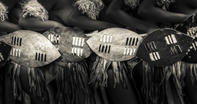KwaZulu-Natal Province waited until 2004 before endorsing a new Coat of Arms. During the 10 year period post elections, KwaZulu-Natal used the arms from both Natal and KwaZulu, placed side by side. The motto, written on a green base in isiZulu is, Masisikume Sakhe, meaning in essence, “let's stand up and build”.

The blazon beneath the Coat of Arms is written in English and isiZulu, the first time in South Africa’s history that a blazon is shown in any language other than English and Afrikaans. From the base is a Nguni shield with a bird of paradise (Strelitzia reginae) flower depicted on it. The green jagged band on the shield represents the Drakensberg Mountains, which border the province with Lesotho and the Free State.
The green represents the overall landscape colour of the KwaZulu-Natal Province. Crossed behind the shield are an assegai and a knobkierie, both traditional symbols of chiefly authority. The shield is supported by a lion (Leo leo) which was part of the old KwaZulu arms and represents the authority of the Zulu king.
On the other side of the shield is a black wildebeest or gnu (Connochætes gnu), which was formerly part of the symbolism of the Colony and Province of Natal since 1870, and part of its coat of arms since 1907. In the new Coat of Arms, the gnu is depicted as rampant rather than running, as in previous arms. Above the shield is the crest shaped like a beehive hut. This was the traditional structure used to make homes of the abeNguni.
These structures were also typical of the southern Nguni of what used to be known as the Transkei and Ciskei. Homestead’s of this type were generally composed of many huts, one for the male head of the house and one each for his wives and children. This type of building style is now mainly abandoned, but can still be seen in historical villages near Shaka’s Kraal.
Shield Emblem - Nguni Shield

The choice of shield is very apt as it reflects the traditions of the warrior amaZulu and their predecessors. This shield shape was first used by abeNguni as a tall shield (2 m tall) in which the warrior hid when long spears were being thrown at him.
Shaka abolished this type of shield along with the long spear, replacing both with a shorter shield to about 1 m, so that it could be used in hand to hand combat along with the assegai (or short stabbing spear).
Now, even shorter shields are traditionally used for stick fighting of young Nguni men. The traditional shields are made of cowhide and reinforced with sticks, which can be removed for easier carrying when not being used for fighting or ceremonies. Thongs hold the sticks in place, often in a contrasting colour to the rest of the shield.